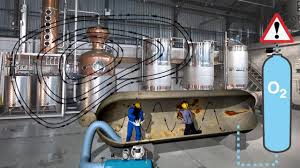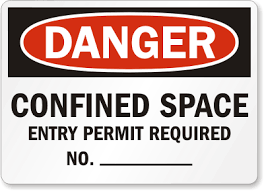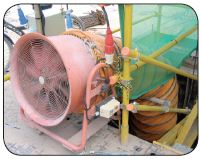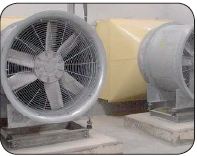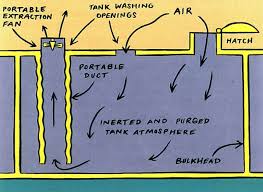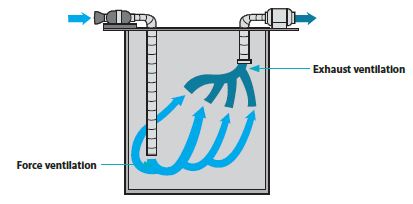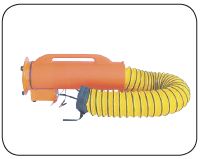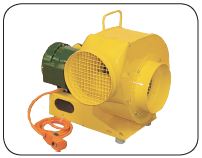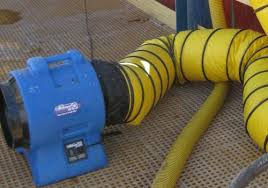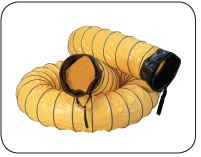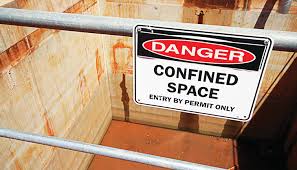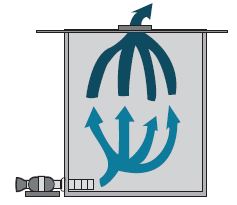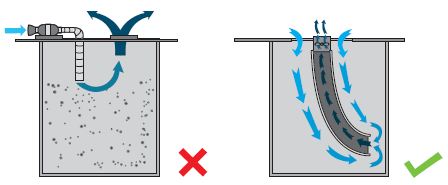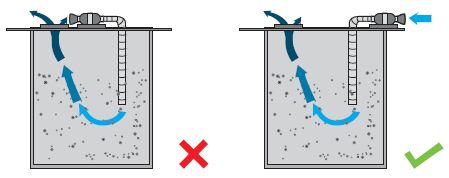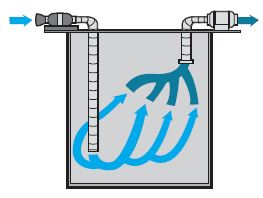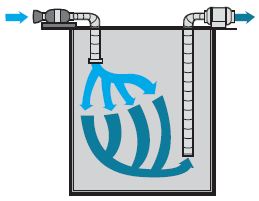Confned space-Purging and Ventilation:
Introduction:
When a confined space is known to contain hazardous contaminants, it is crucial to purge the space adequately before any entry. Subsequently, continuous ventilation should be provided to maintain a safe work environment. It is also important to note that purging and ventilation do not exclude the need for gas testing.
Purging:
Purging of a confined space is conducted before any entry and the purpose to remove any existing contaminants by displacing the hazardous atmosphere with another medium such as air, water, steam or inert gases. The choice of a suitable medium will depend on factors such as nature of the contaminants and their concentrations.
Inerting:
Inerting is a form of purging which involves removing oxygen from the confined space by displacing it with inert gases such as nitrogen (N2) and carbon dioxide (CO2). Inerting is commonly used to remove the potential hazards of fire and explosion by reducing oxygen to a concentration that is below the level that can support combustion. When inerting, care must be taken to ensure that following the purging of the contaminants with inert gases, the space must be ventilated with fresh air to restore the atmosphere to normal atmospheric condition. Also, when purging flammable substances, the equipment used such as nozzles and pipes must be bonded to the space to prevent the build up of static charges which can cause ignition.
Purge Time:
The amount of time that is required to remove the contaminants is dependent on the concentration of the contaminants and the capacity of the air moving devices used. If no further contaminant release is expected (static condition), the following formula can be used to calculate the amount of time needed.
Q = V / T Ln = Co / C
Where : T (min) is the time required
Q (m3/min) is the quantity of the supplied purging medium
V (m3) is the confined space volume
Co (ppm) is the initial concentration of the contaminants
C (ppm) is the final concentration of the contaminants after T mins
The above requirements assume an ideal mixing and distribution of supplied air. In practice, higher
rate of ventilation may be necessary depending on the efficiency of supplied air distribution.
Ventilation: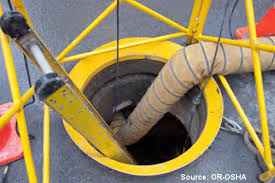
It is unsafe to enter any confined space when adequate ventilation is absent. Adequate and effective ventilation is required throughout the validity period of the entry permit. Even when the confined space has been certified safe for entry, new contaminants may be introduced from the change in conditions, or when work performed in the space such as welding releases new contaminants.
As such, it is important to provide an adequate and effective ventilation to always maintain the contaminants concentration level as low as possible, and the level of oxygen within safe range.
Ventilating Confined Spaces Rich with Flammable Gases/Vapours:
In some instances, ventilating confined spaces that are filled with flammable gases/vapours can be dangerous, especially if the original concentration of the flammable contaminant was above the Upper Explosive Limit (UEL) range. By ventilating with fresh air, it will “lean out” the concentration of the contaminant and lower it to below the UEL and within the explosion range. This would make ignition for fire and explosion possible.
In such cases, the use of exhaust ventilation or dilution ventilation using inert medium such as nitrogen (N2) should be considered.
Type of Ventilation and its Uses:
Due to the unique characteristics of confined spaces, natural ventilation is usually not adequate
and would require the use of mechanical ventilation. Mechanical ventilation can largely be
classified into two main types:
- Forced (supplied) ventilation; and
- Local exhaust ventilation (LEV).
Factors to consider in determining the type of ventilation to use include:
- The nature of contaminants;
- The configuration of the space; and
- The expected work to be performed in the confined space.
Forced (Supplied) Ventilation:
Forced or supplied ventilation introduces fresh air into the confined space through the use of a mechanical air moving devices such as a blower. The constant supply of fresh air in sufficient
quantity will help to maintain the level of oxygen in the space within the safe range, as well as dilute the level of contaminants released in the confined space to an acceptable level.
Forced ventilation used to dilute contaminants is usually more suitable when:
- The contaminants released are of relatively low toxicity (as a general guide, contaminants with PEL of equal or higher than 500 ppm is deemed to be slightly toxic);
- The rate of emission or release is relatively constant and is of small quantities;
- Contaminants are gases or vapours or finely suspended solids;
- The release of the contaminants is widespread; or
- There is sufficient distance between the worker and the source and allow effective dilution to take place.
It is important to ensure that air moving device is placed where the air is drawn into the confined space from a contaminant-free source. For example, it is not appropriate to place the air moving device behind a diesel generator where the exhaust gas of the generator could be drawn into the confined space.
For a continuous release of contaminant into a confined space, the forced ventilation Q (m3/min) required to dilute the contaminant (molecular weight MW) which is generated at a constant rate of E (gm/min), to a permissible exposure concentration of C (ppm) at 250C and 760 mmHg is:
Q = E x 24.5 x 106 / MW x C
Where : E (gm/min) is the rate of contaminant generation
MW is the molecular weight of contaminant
Q (m3/min) is the quantity of the air supplied
C (ppm) is the PEL of contaminant
Local Exhaust Ventilation (LEV):
Exhaust ventilation is achieved by pulling air out of the confined space and in the process, removing the contaminants from inside the space. LEV is a specific application of exhaust ventilation where the extraction is applied directly at the contaminant source. The use of LEV should be considered when dilution ventilation is not effective due to restrictions in the confined space or when high local concentrations of contaminants may occur during work activities such as welding and chemical
cleaning.
In general, LEV is suitable when:
- The released contaminants are of relatively moderate to high toxicity (as a general guide, contaminants with PEL of lower than 500 ppm is deemed to be moderate to high toxicity);
- The rate of emission or release is of large quantity;
- The contaminants are fumes or solids that are difficult to remove by dilution ventilation;
- The release of the contaminants is localised; and
- There is insufficient distance between the worker and the source to allow effective dilution to take place.
For LEV to be effective, it is crucial to place the exhaust hood Figure : Example of local exhaust ventilation. close to the contaminants’ source. It is important that the exhausted air is discharged outside the confined space to avoid re-introduction into the space. In addition, it is also important that the fan capacity is adequate to pull the contaminants into the exhaust hood, move them along the duct and discharge into the atmosphere outside the space.
As LEV removes air from the confined space, it creates a slight negatively pressured environment
in the space. Therefore, it is important that replacement air is provided in the form of supply
ventilation.
Push-pull System:
A push-pull system uses a combination of both forced ventilation and exhaust ventilation. It usually provides more effective ventilation of the space than using any of the ventilation system alone, and is recommended for use whenever practicable. The push-pull system introduces fresh air into the space while removing contaminants by exhausting them.
Air Moving Devices:
There are typically three types of air moving devices that are used in the mechanical ventilation
of confined spaces. These are: Figure : Example of axial-flow fan.
Axial-flow Fans:
Axial-flow fans are designed to move air parallel to the axis of rotation of the blades. The operating principle is similar to that of standing fans used at home. Axial-flow fans can be used for both forced or exhaust ventilation and are most effective for moving high volumes of air under relatively low airflow resistance, such as when minimal or no tubing is attached. However, care is necessary when flammable gases/vapours are present as the fan motor is in the direct path of the airflow and can act as an ignition source. It is important to consider using an explosion-proofed fan for such an application.
Centrifugal-flow Fans:
Centrifugal-flow fans, or radial-flow fans, move air perpendicular to the axis of rotation of the blades.
Centrifugal-flow fans tend to be heavier, bulkier and generally produced lower airflow but higher static pressure as compared to axial-flow fans. This ability to generate high static pressure is important in application such as in LEV especially where long runs of ducting may be used.
Venturi Eductor:
Venturi eductors are powered by compressed air or steam. The air or steam is released into the eductor through a nozzle at high velocity and this, in turn, induces air into the inlet and forces it along the tube for discharge at high velocity. Eductors are usually lighter, more compact and less expensive but they are not able to move large volumes of air and require a significant supply of compressed air or steam to operate. In addition, the high velocity air movement may also generate static electricity that could serve as an ignition source.
Ducting:
Ducting is used widely and extensively to channel air to and from confined spaces. There are two
main types of ducting commonly used:
- Flexible collapsible ducting; and
- Flexible non-collapsible ducting.
It is important that the ducting length be as short as possible and that the number of elbows or bends in the duct are kept to a minimum to reduce friction loss. Friction loss will reduce the efficiency of the ventilation and could potentially result in lower than the designed/calculated capacity.
Flexible Collapsible Ducting:
Flexible collapsible ducting, such as plastic material tubing is commonly used. Such ducting lacks
structural support and can only be used for forced ventilation. While they usually cost less and
are more flexible, the lack of structural support can often result in less effective ventilation due to
increased static pressure drop across the ducting.
Particular care is required when using plastic material tubings as they are more susceptible to wear and tear during use. It is also important to note that such plastic material tubings are combustible. When they catch fire, smoke/toxic gas will be emitted and travel back to the confined space.
Flexible Non-collapsible Ducting
Another type of ducting used is the flexible non-collapsible ducting. It usually has a wire helix that provides the shape and prevents collapse. Such ducting offers strength, flexibility and can be compacted for storage. Flexible non-collapsible ducting can be used for both forced and exhaust ventilation.
Effective Ventilation:
Another key component of ventilation in the confined space is to ensure that the ventilation systems in place are effective. As a general principle, ventilation systems should be set up with the following considerations:
- Long confined space;
- Deep confined space;
- Prevent short-circuiting;
- Prevent re-circulation of exhaust air;
- Remove lighter-than-air contaminants; or
- Remove heavier-than-air contaminants.
Long Confined Space:
For a long confined space, fresh air is blown in at one end of the space and the contaminated air
is being exhausted at the other end. If necessary, use a series of fans (do not connect them) to move air through long distances.
Deep Confined Space:
For a deep confined space, the fresh air is blown into the bottom, and the contaminated air is being exhausted near the top.
Prevent Short-circuiting:
To prevent short-circuiting in a confined space that has only one opening, use a powerful blower to blow clean air into the entire space or a long ducting to reach the bottom of the space.
Prevent Re-circulation of Exhaust Air:
To prevent re-circulation of exhaust air in a confined space, position the air intake away from any
contaminated source. This includes facing away from the opening of a confined space.
Remove Lighter-than-air Contaminants:
To remove lighter-than-air contaminants from a confined space that has two openings at the top of the space, use a blower and duct work to introduce fresh air to the bottom of the space. Place an exhaust fan at the other opening to draw the contaminated air from the top.
Remove Heavier-than-air Contaminants:
To remove heavier-than-air contaminants from a confined space that has two openings at the top of the space, use an exhaust fan and duct work to capture the low-lying contaminants. Place a blower at the other opening to provide fresh air to the space.
Click the below link to use more details about confined space

Confined space safety check sheet
Confined Space - Tool Box talk
Confined space - Dos and Don ts
Deadly space
Case study
